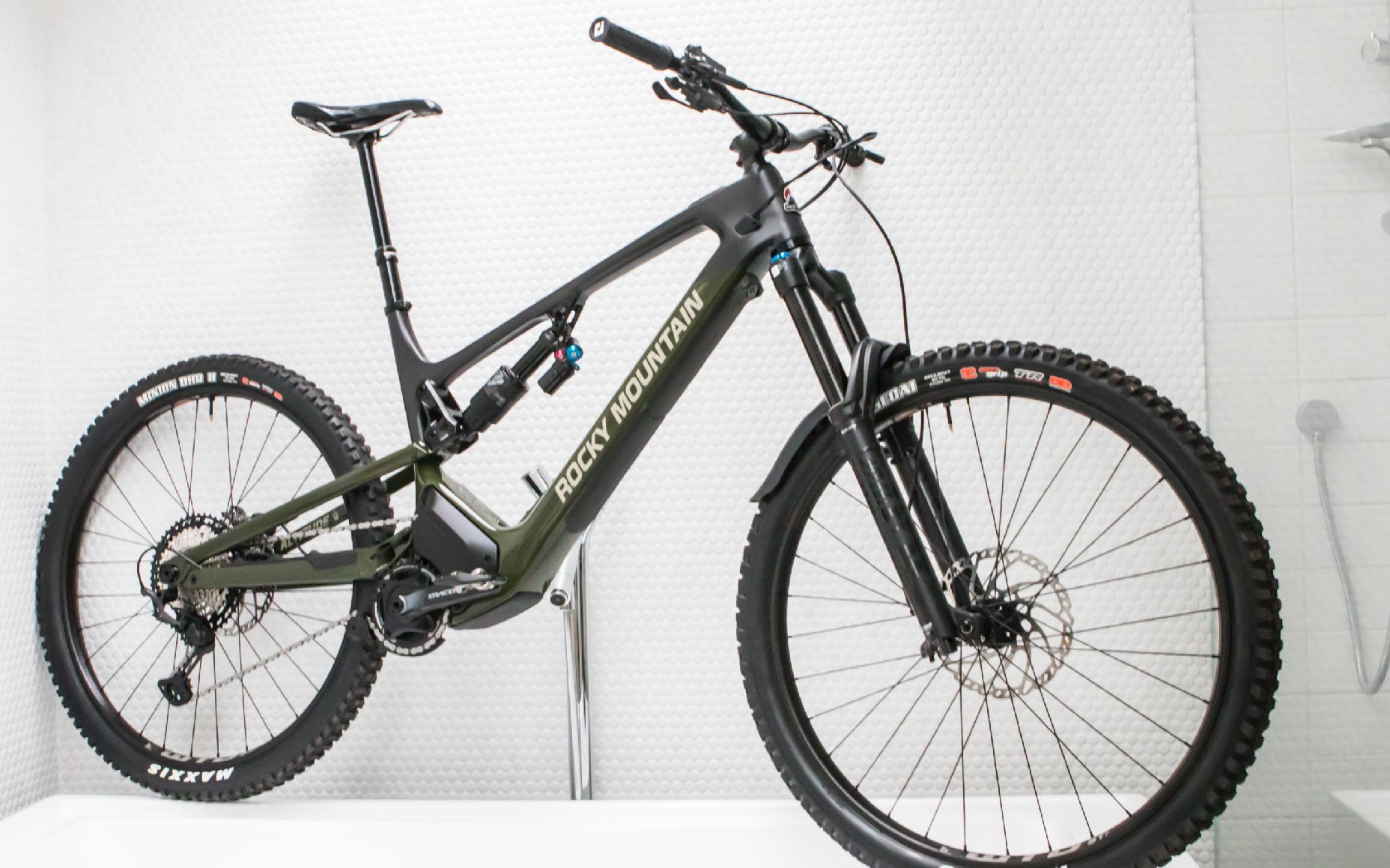
First Impressions Review
2022 Rocky Mountain Altitude Powerplay with Dyname 4.0 Motor
As time goes on I am becoming less sheepish about riding eMTBs and I'm enjoying the experience more over time as well, as I figure out new rides and become accustomed to the increased heft. I don't love riding under my own power any less however, which is a relief because I feared that was inevitable. In fact, if I've been riding an eMTB for a couple of rides in a row for testing purposes, I get quite excited about jumping on a more spritely steed. eMTBs are here to stay, but mountain bikes aren't going anywhere either if my experience is a good barometer.
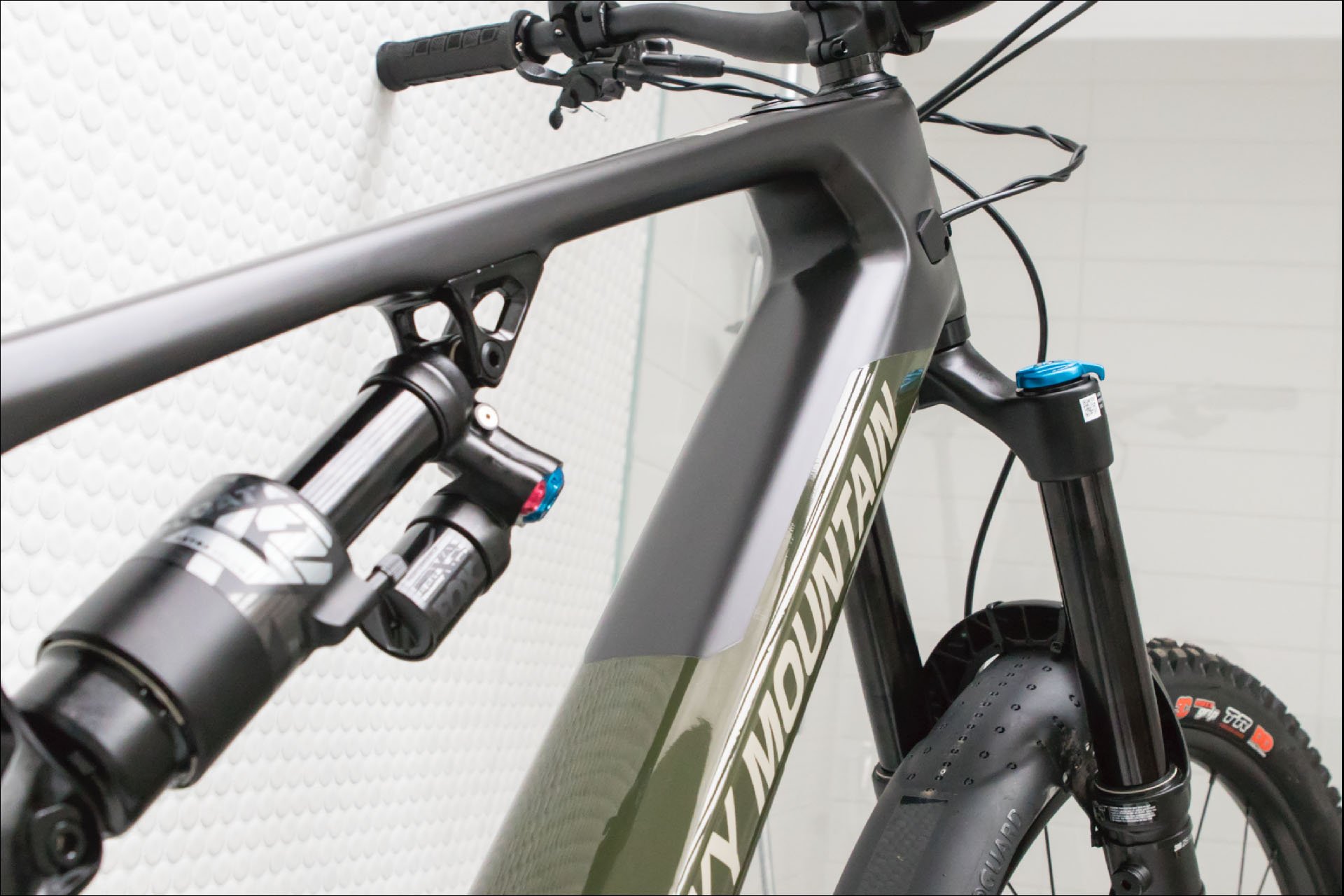
The matte black and "War Machine Gloss" paint is complemented by "Enter Sandman" lettering. This is a fine looking and well-finished bike.
Rocky Mountain's Powerplay models have been well received by the riding public, which is a big achievement for a relatively small brand, particularly considering they opted against an off the shelf motor from Shimano, Bosch, or Yamaha.* The previous generation, which performed very well, lacked the polish of some of the bikes from Santa Cruz, Specialized, or Trek however. Most of these gaps were in small details, but there were some larger issues with the previous generation Powerplay bikes as well.
*The Dyname 4.0 motor was developed in partnership with Propulsion Power Cycle, a Canadian company based in Québec
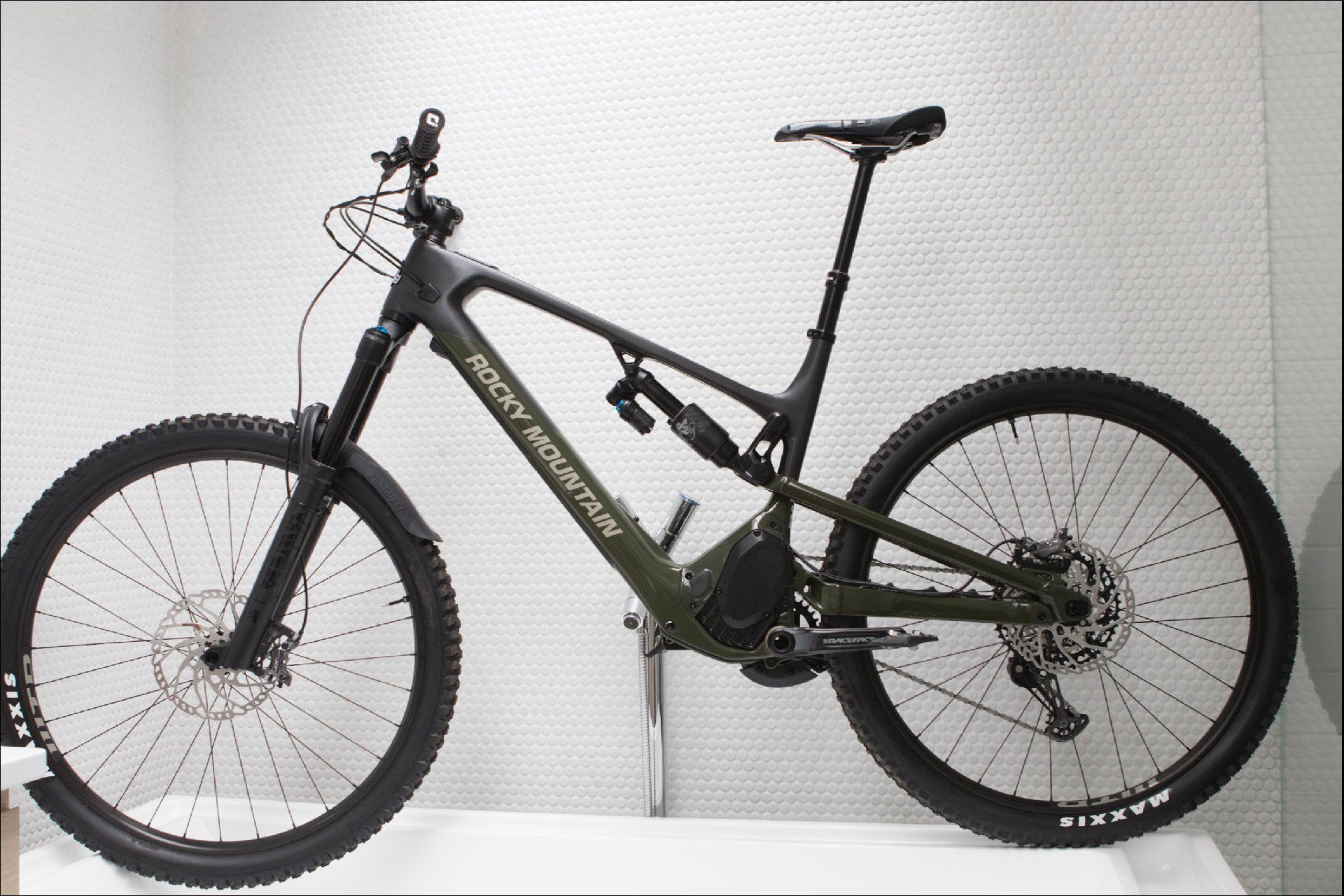
The weather was horrendous and Deniz is away, so I opted for an indoor shoot.
My biggest complaints about the previous model related to a few mission critical elements;
- The absence of a display to communicate battery level and power level, which were both expressed with the same LED lights on the controller, was a big one. This led to range anxiety and confusion as a struggled to remember what each colour meant and/or blink represented. That has been addressed with the "Jumbotron" and while it isn't as large as the name would suggest, it does a respectable job of communicating the most important information.
- On the previous generation I once ran out of juice after a long ride about 2 kms downhill from home. Normally this wouldn't be a big deal, but the previous Dyname drivetrain produced significant resistance without electric assistance, and those 2000 metres hurt as a result. The new system does away with the upper chain slider and has addressed this issue effectively.
- The aforementioned improvements to the drivetrain also dealt with what I felt was excessive mechanical noise, now making the Altitude PP one of the quietest and least offensive-sounding eMTBs I've ridden.
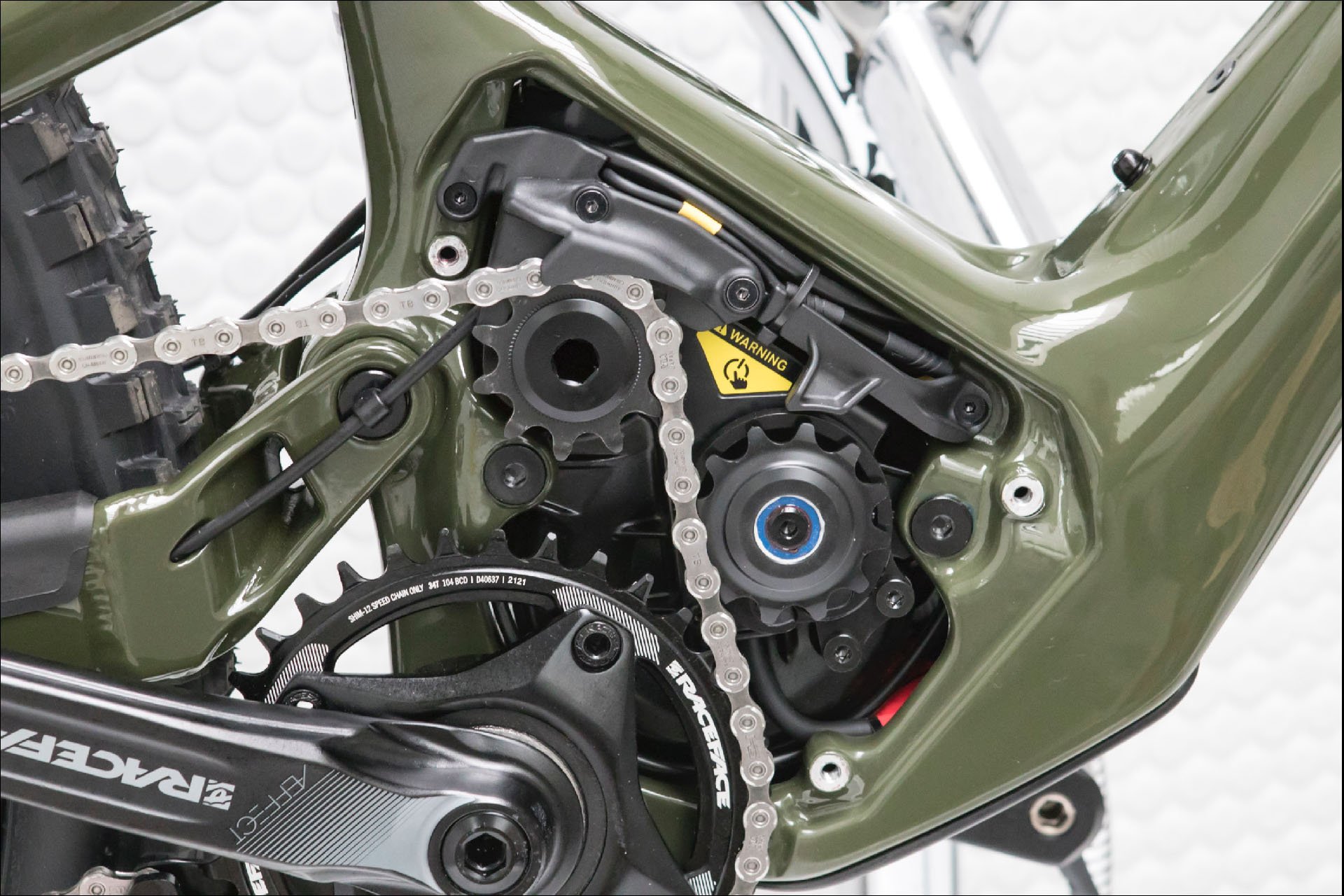
The new motor has a better line, doesn't require the upper slider seen in the next image, and it appears, based on deflection seen, that the torque sensor applies less force to the chain,
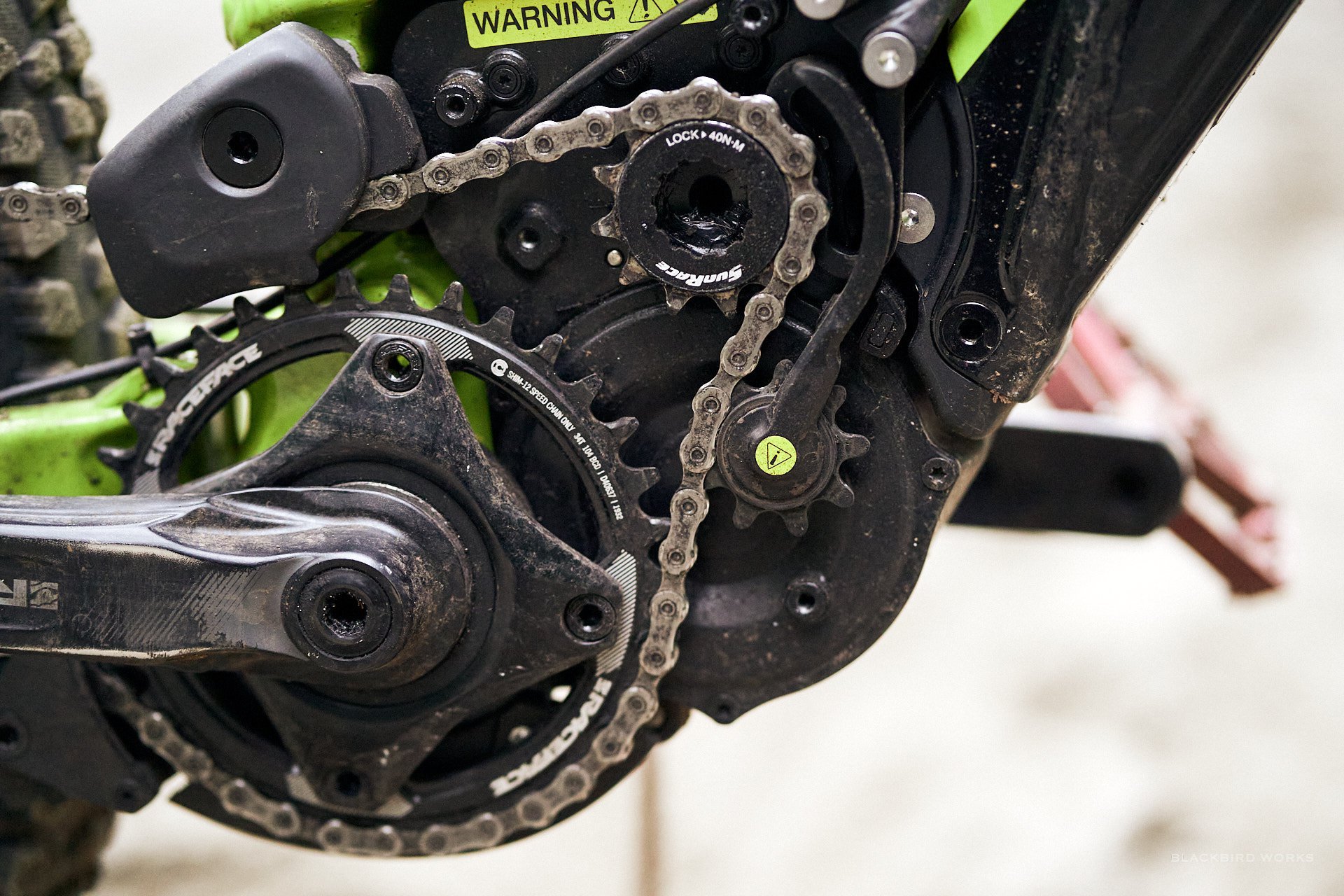
The previous Dyname system is larger, heavier, louder, and it produced more pedalling friction.
Dyname 4.0 Motor
The eMTB arms race is heating up, and motors are clearly the main battlefield, since battery technology seems relatively consistent across different brands. Both Shimano and Bosch have recently released new motors, and Rocky Mountain is releasing the new Dyname 4.0 power plant with the new Altitude and Instinct models. It is both smaller and lighter but the big improvement I noticed was significantly quieter operation. The previous generation Dyname didn't whine like other motors but there was a significant mechanical sound coming from the enclosure. This has been reduced significantly and the result is one of the quietest eMTBs I've ridden. The sound is also more pleasant to my ears, apparently because the motor operates at lower RPM resulting in lower frequency sounds compared to the whine emitted by other motors I've ridden.
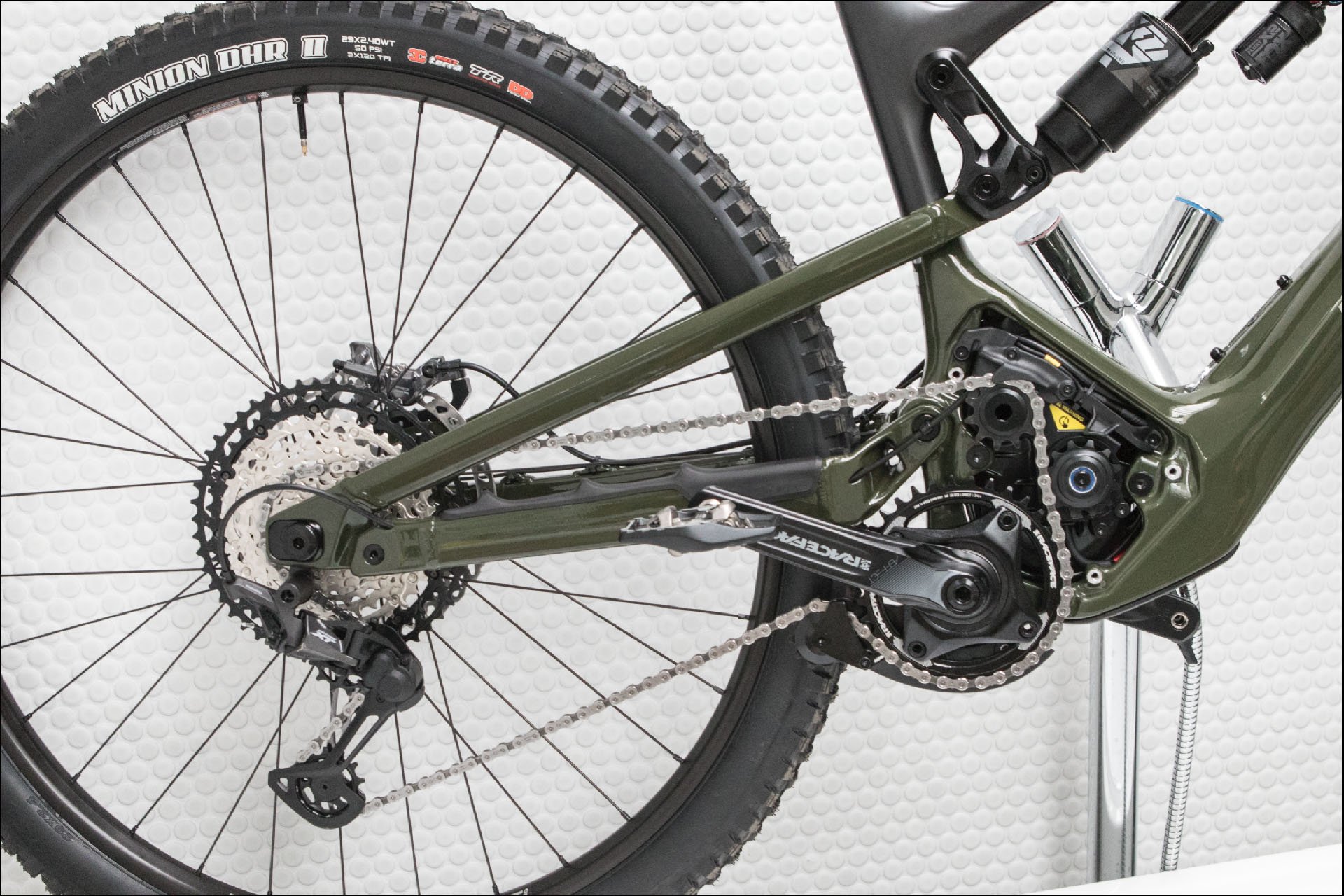
The drive pulley now aligns with the main pivot thanks to the mid-high placement, helping to neutralize pedalling force impacts on suspension and increasing anti-squat values. A more rearward axle path is also said to improve small bump performance.
I also notice a difference in terms of power delivery compared to the Shimano EP8. When I put the power down on the Altitude PP, the increase in power is instantly felt and it feels more noticeably proportional to my input than others as well. At times it feels like it requires less effort to go faster because of immediacy and what I would describe as the progressiveness of the power delivery. Other motors feel as though they have a more linear power delivery in comparison, which to me feels less effective and satisfying at the pedals.
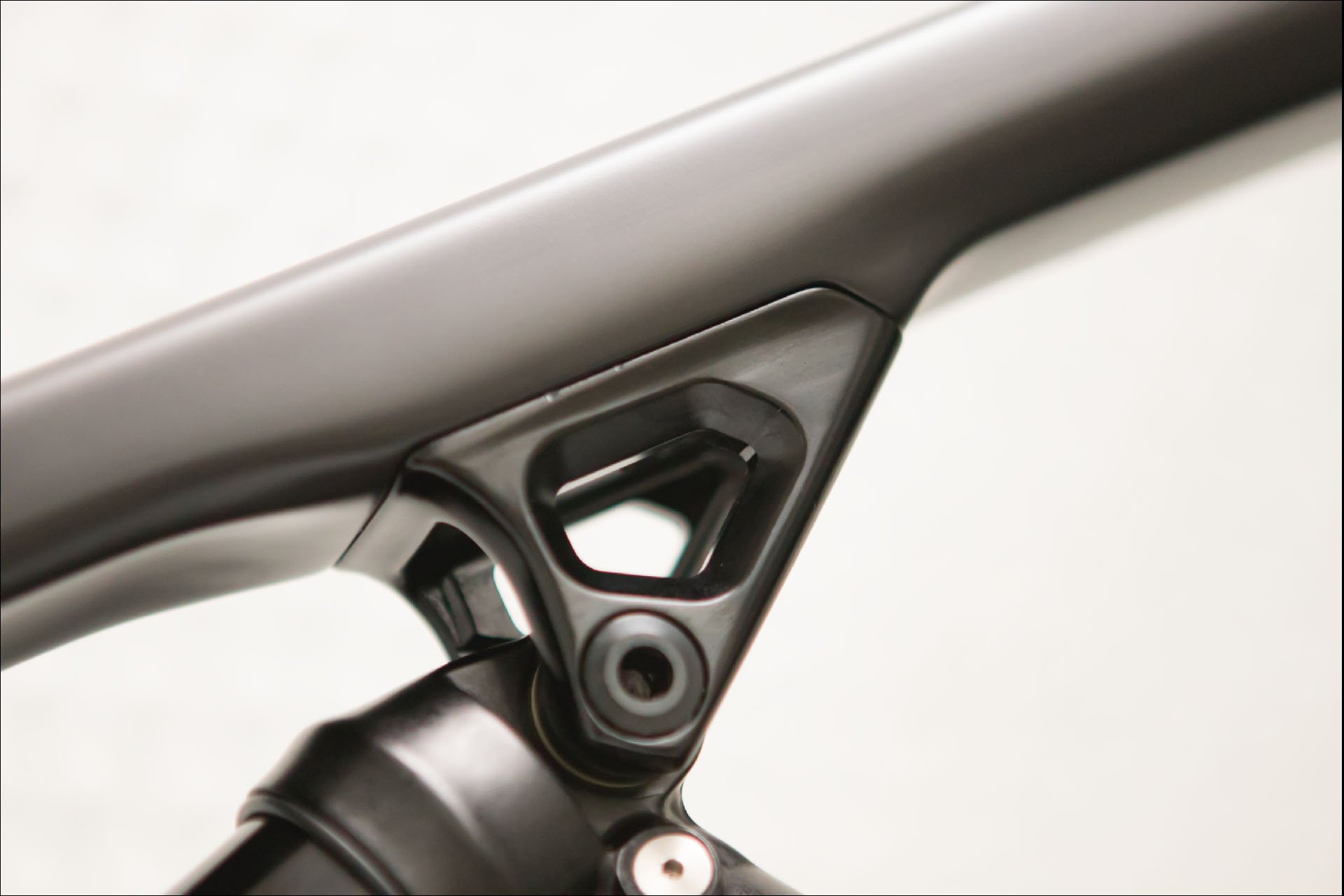
I find the industrial design of the smoothly integrated modular shock mount very satisfying for the eyes.
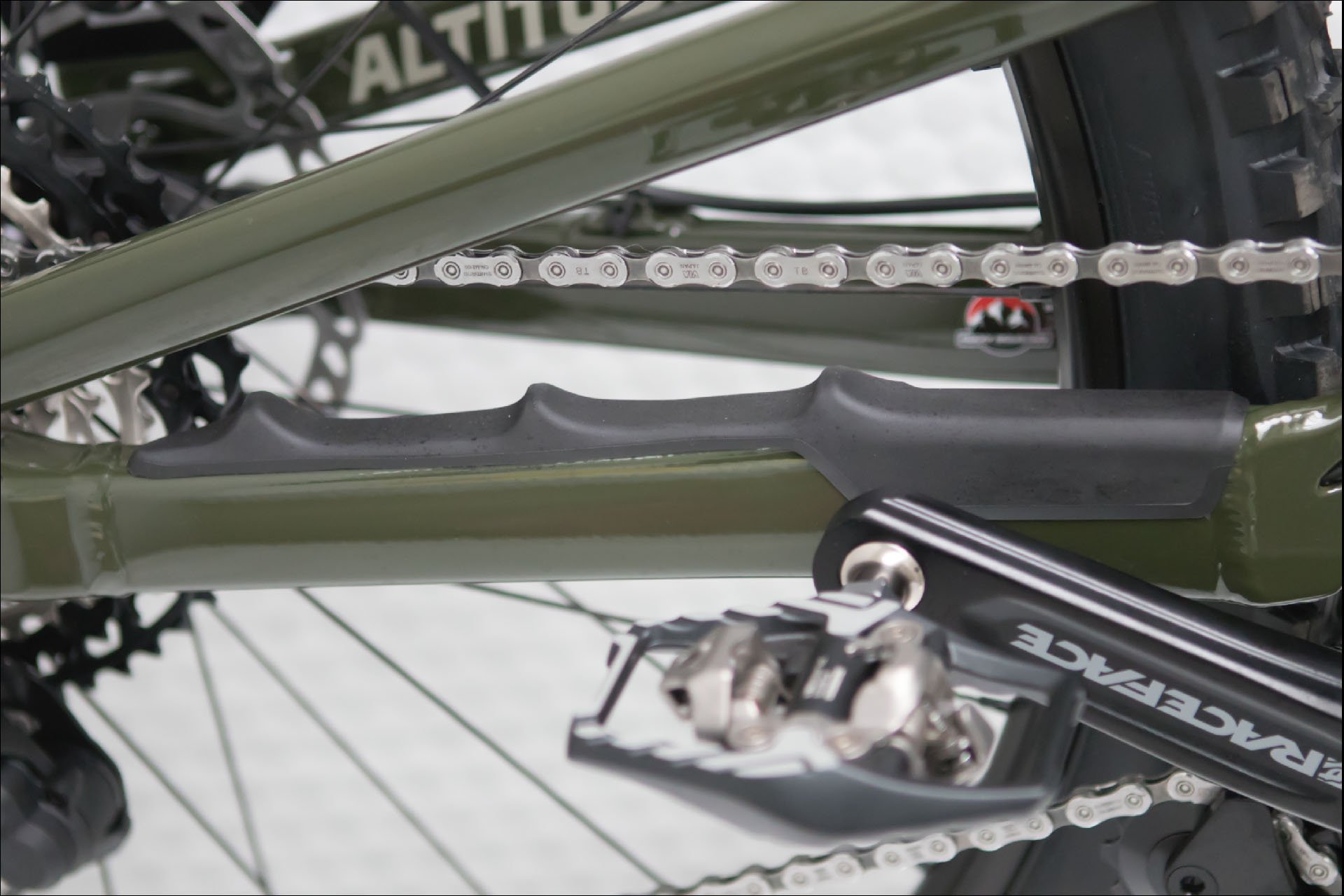
The shark-finned chainstay guard effectively dampens chain noise.
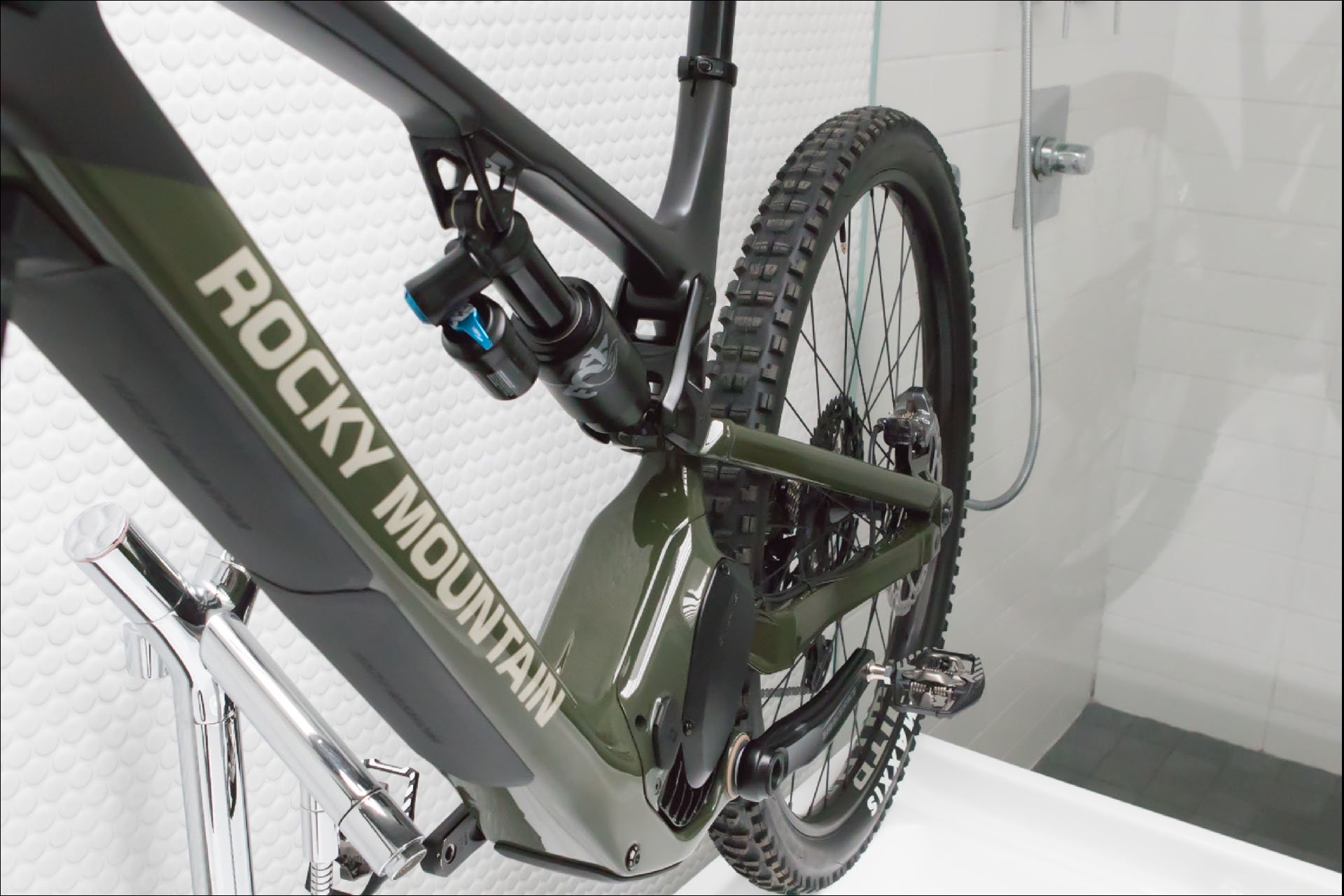
Details are well taken care of, but the downtube protection confused me. Based on the shape I assume these were tailgate guards and I happened to receive two. Alas they are meant to protect the lower parts of the downtube from impacts and if I had started at the bottom the upper guard would likely have mounted high enough to protect the downtube from gate damage.
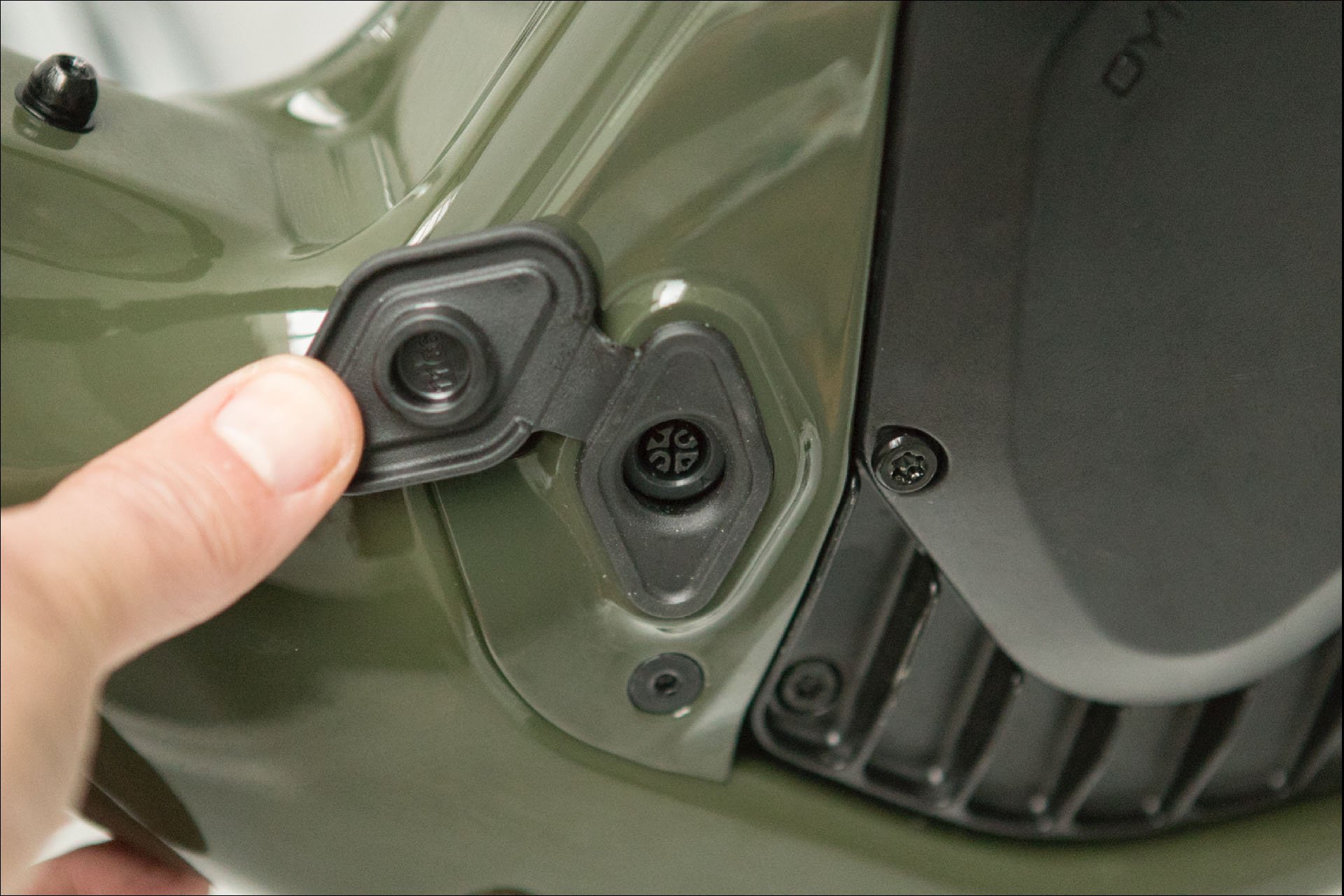
The new charging port has improved sealing and is more compact. To my naked eye (without my glasses) the interface appeared symmetrical but in fact the four elements that make up the female part of the plug have 3 different shapes and it only charges with the plug pointing up. I figured this out too late but without any damage done.
Altitude Powerplay Carbon 70 Features, Improvements, and Highlights (info from RMB)
- Dyname 4.0 drive system w/ 700w power and 108 nm torque (peaks)
- Quieter operation
- Improved un-aided pedalling
- 170mm, 44mm (FOX) or 42mm (RockShox) offset fork - rear travel of 160mm with
- Max tire clearance is 29 x 2.6
- Sizes: SM - XL
- Weight - 23.53 kg (51.9 lbs), size LG
- Ride-4 adjustment system
- Modular Shock Mount for future proofing
- Dual bearings at seat stays and chain stays
- Integrated Jumbotron display
- 720 Wh battery (up from 672)
- Smaller remote
- Mid-high main pivot
- 10mm chainstay adjustment
- More rearward wheel path and increased progression in shock rate
- Improved small bump performance
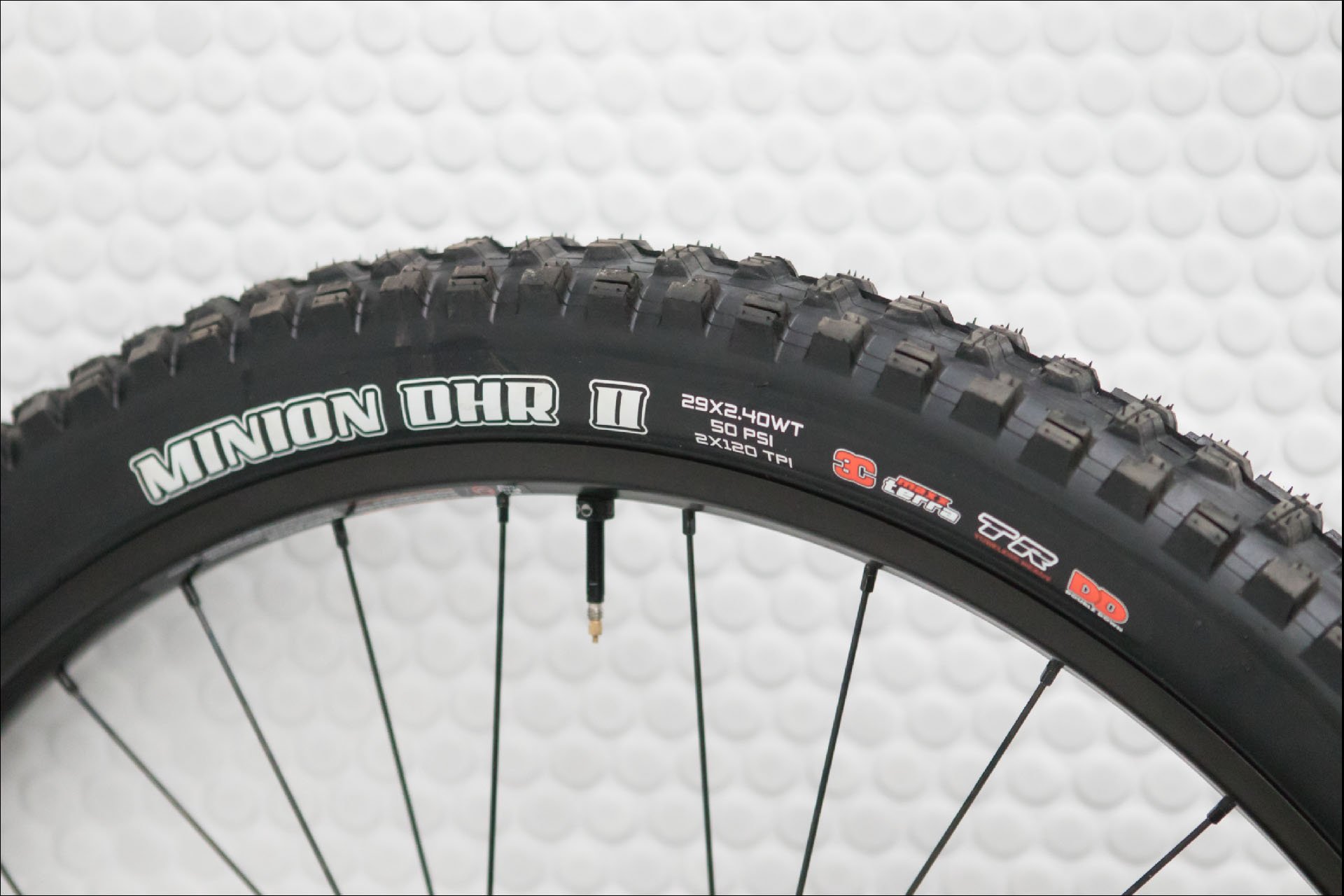
Tire spec is all you could ask for; 29 x 2.5 Maxxis Assegai 3C Maxx Grip up front and a 2.4 DHRII Maxx Terra in the rear, both with DD casings. What's more is the bike comes with Cushcore installed.
Descending Performance
The first thing I noticed both up and down with the new Altitude PP, was improved traction. The rear wheel tracks very well, perhaps because of the mid–high main pivot and the more rearward axle path. It also deals with large hits effectively and tracks very well, both in corners and when things get lumpy. The counter point to this stuck to the ground feeling is that it is indeed a little earthbound when it comes time to get off the earth. I'm hoping I can make it feel a little more poppy with some tuning refinements (both the shock and the Ride 4 adjustment) but thus far it isn't as playful as I'd like, even for a ~53 lb 24 kg (size XL) eMTB.
After four rides (3 if them at Megavolt) I have found the Altitude PP most at home at speed and in rough and rocky situations and a little less competent in tighter terrain. The reach is on the long side for me and I may be able to address that with the Ride-4 system, but I have thus far left the chainstays in the shorter setting. It's early days however and an adjustment period is to be expected. In other ways I've felt right at home on the new Altitude PP.
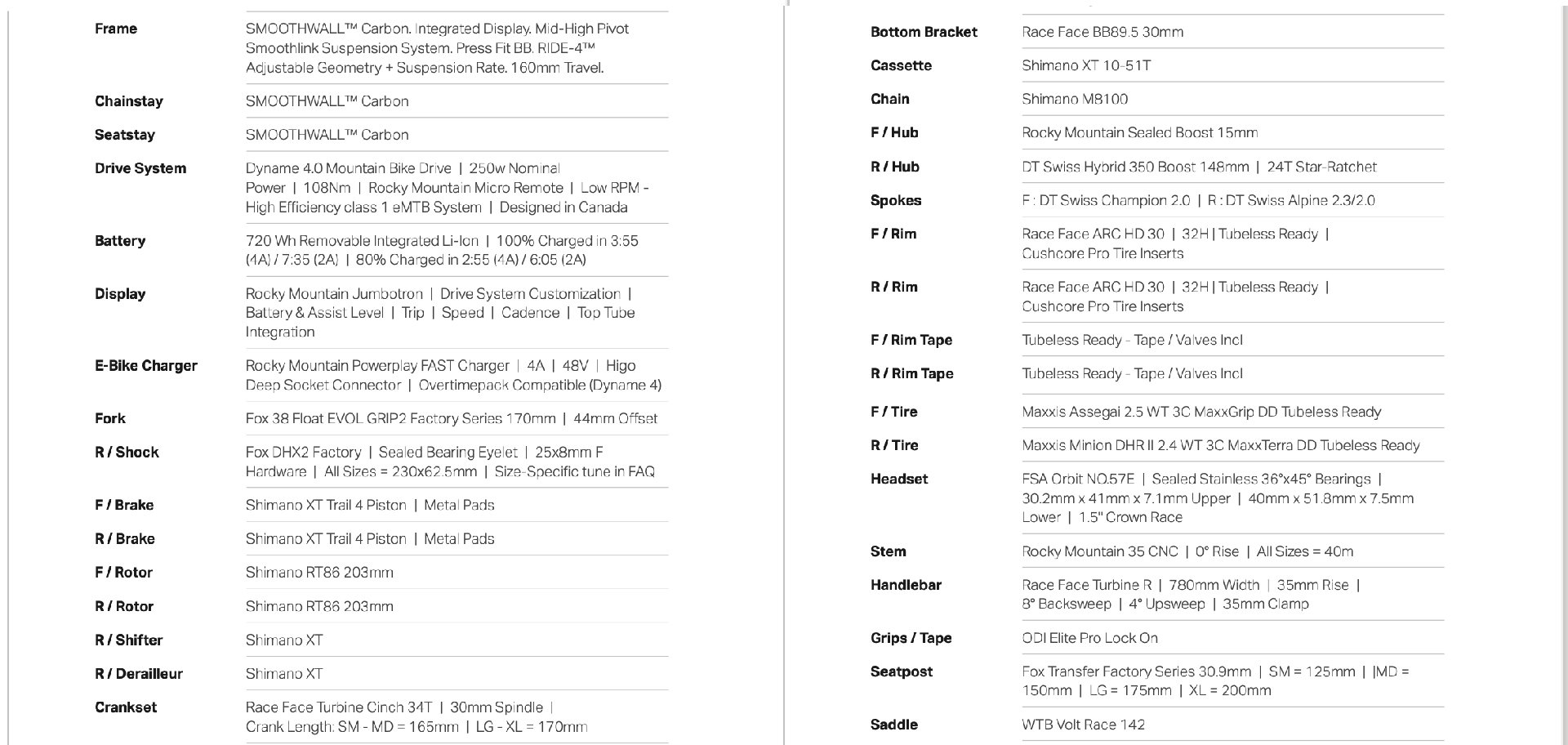
There is an error for the stem spec. which should read; Rocky Mountain 35 CNC | 0° Rise | All Sizes = 40mm
Component Spec.
There is little to argue about here. The Maxxis DD tires tick all the boxes, Cushcore is an inspired addition, and the Shimano XT components perform extremely well. I particularly appreciate Shimano drivetrains on eMTBs because they shift so well under power. It's common to hear a loud clunk accompanying a SRAM shift on one of these bikes but it's rare with Shimano. The unidentified (but apparently Rocky-branded) stem appears a little sub-standard on a bike that retails for 11,400 CAD, along with the Rocky Mountain-branded bar but they do the job fine.
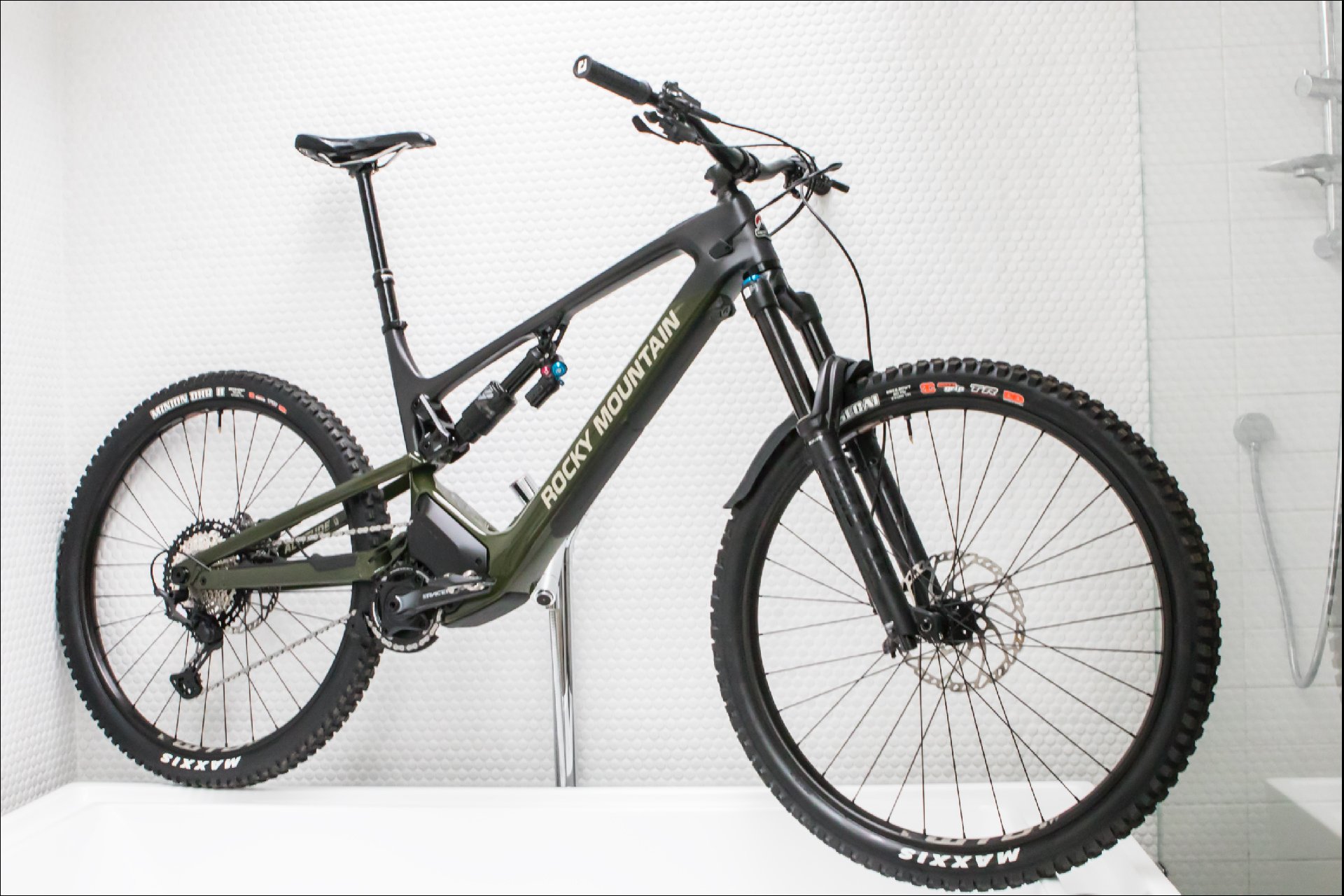
This is the nicest looking Rocky I have seen in a long time.
I appreciate the size-specific seatposts, but my XL came with a 170 post rather than the specified 200mm, and it was certainly missed. I've been climbing with my saddle a little low so it's more out of they way for descents. This has probably contributed to the bike feeling a little unwieldy in tight sections of trail as well.
I like the Fox X2 performance shock and I wish this model was available for the after marktet. It peforms well and keeps the MSRP down. I'd prefer to see a Grip 2 damper on the fork but the Fox 38 Evol Float Grip (44mm offset) is feeling better with every ride.
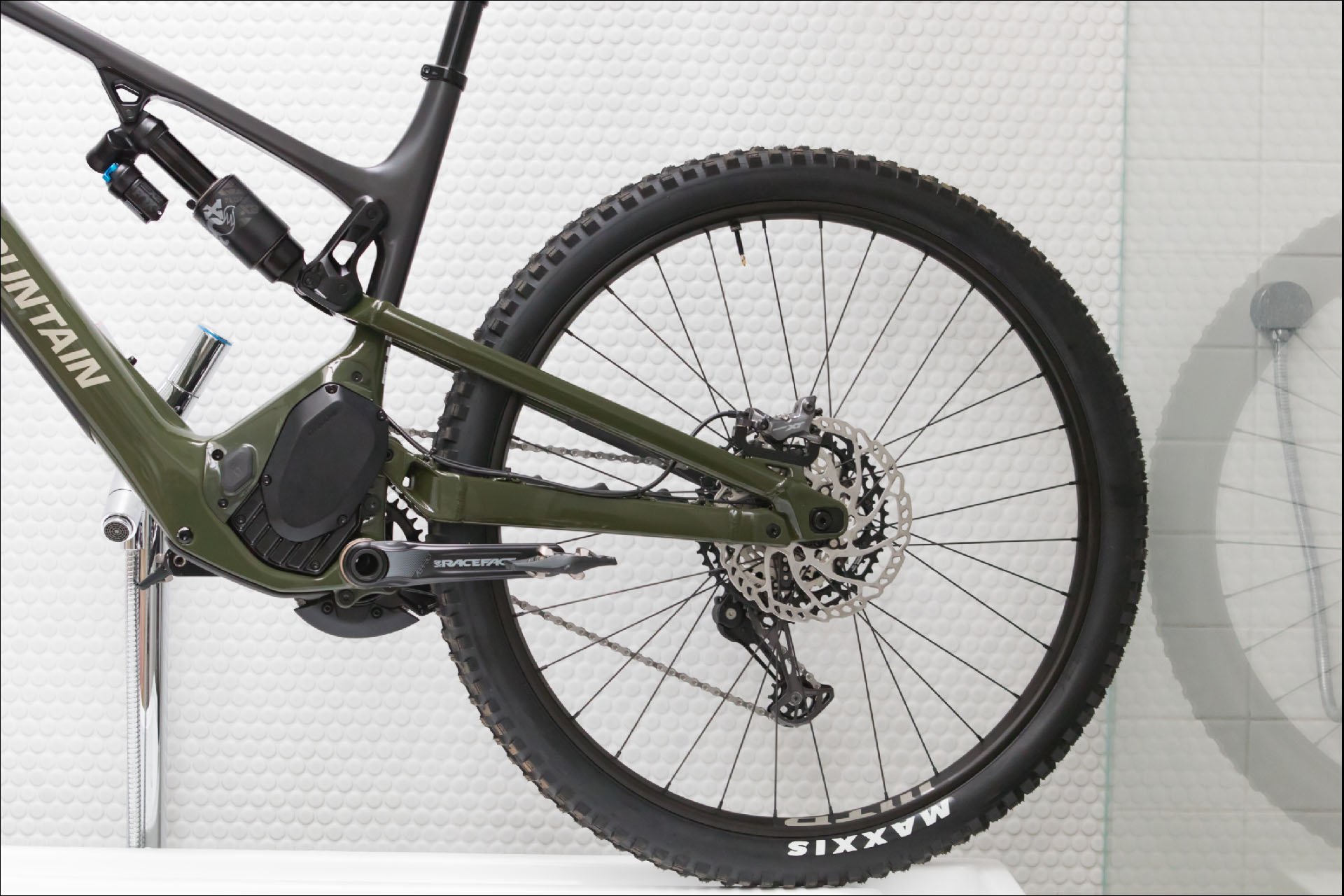
All the details on the new Powerplay models are a step up. I found the previous motor covers a little flimsy (I managed to crack one in fact) and they looked a little slapped together and didn't seem to provide adequate coverage against the elements. The new covers are well integrated and solid feeling and they do a great job keeping out muck and moisture.
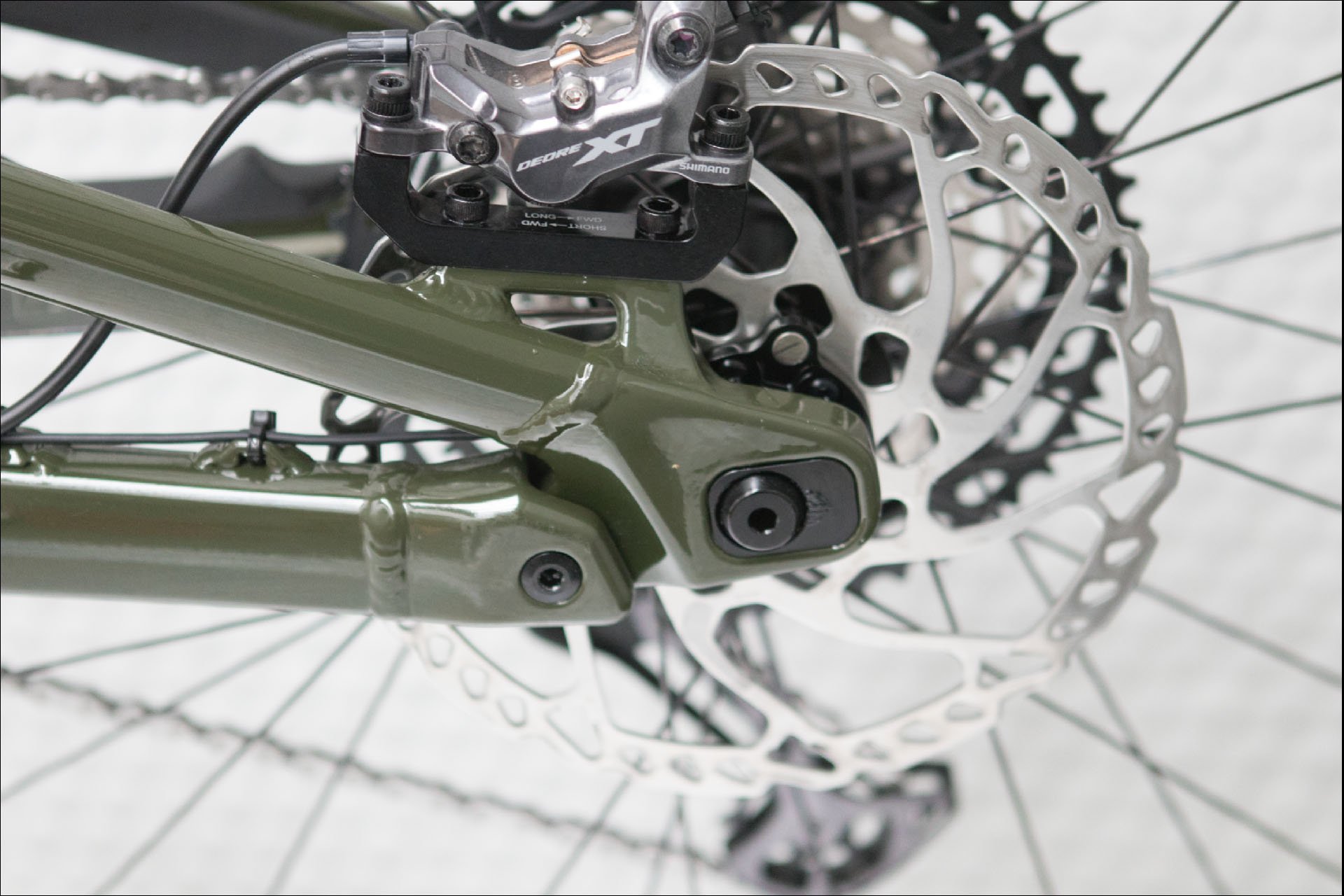
Rocky Mountain's move from bushings to bearings has been well-received by mechanics and riders alike. The new Altitude and Instinct take it a step further by doubling the bearings at the chainstay and seat stay pivots.
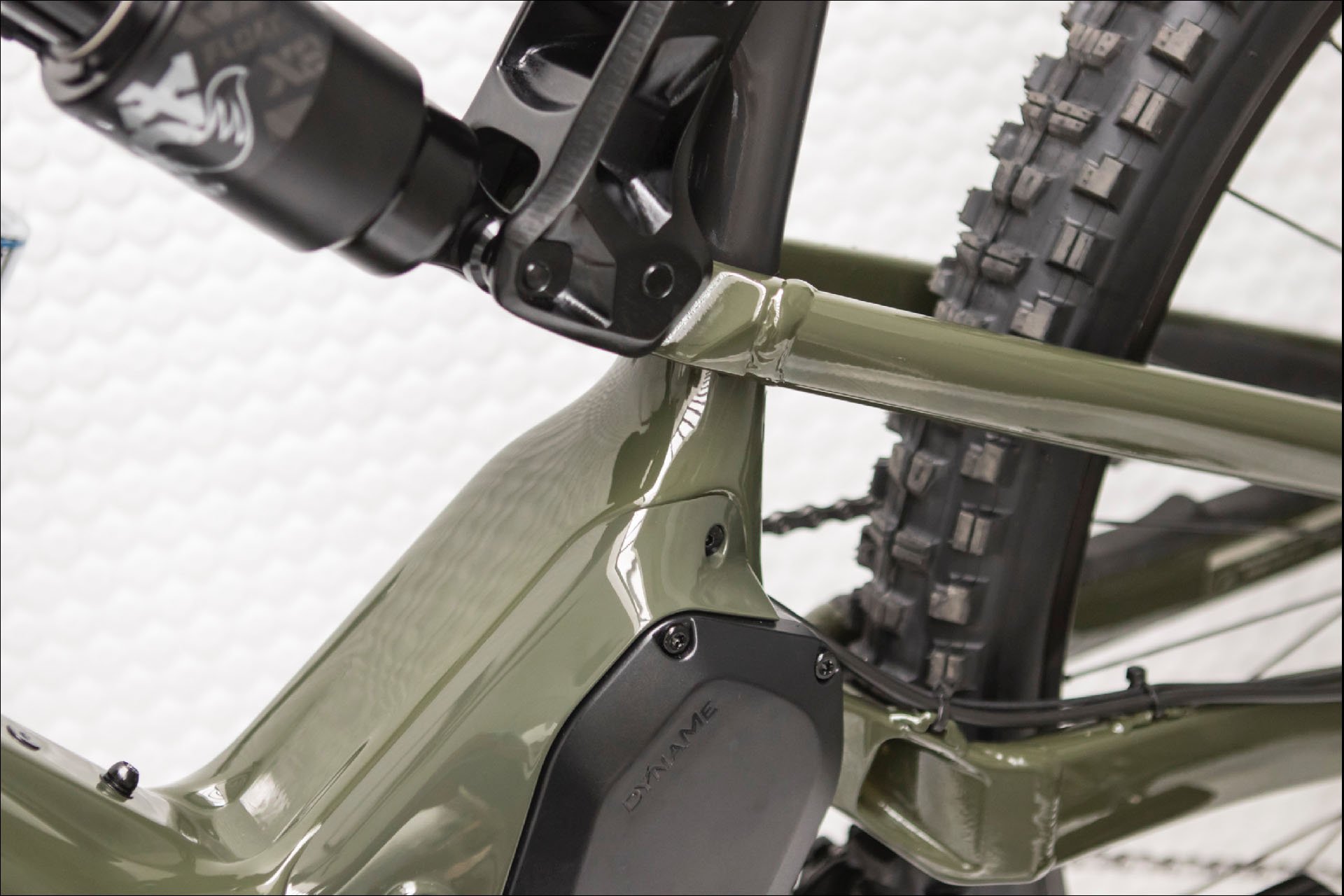
Fit and finish are top notch.
Adaptability
While the new Powerplay models have easily removable batteries (I've been told, but haven't done this yet) there aren't other sizes available to swap in like Norco's new system. There is however a new generation of Rocky's Overtime Pack which bolts on to the water bottle mounts and provides an extra 314Wh for a total of 1034Wh. I have yet to see the new version of the booster but I hope to have an opportunity to try one out. Beyond that the Ride-4 system and the two chainstay length options allow for individual customization.
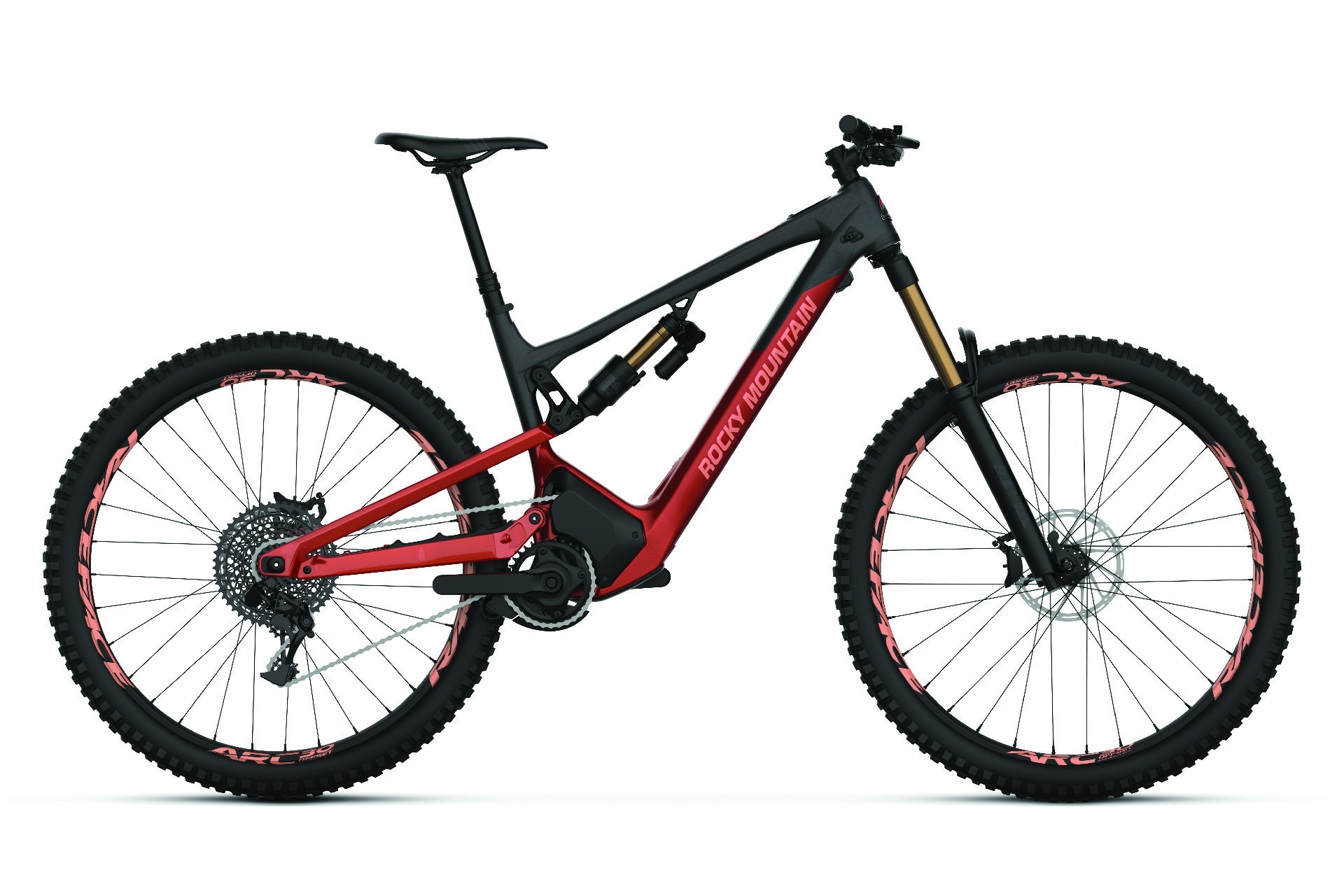
This is the other paint scheme available on the new Altitude PP.
TBD
I have barely scratched the surface with this bike and there is much to learn. I haven't yet played with the programming using the Jumbotron to try the other power modes but I'm keen to try those, both to conserve battery and to get more juice for steep climbs. The other feature I need to mess with is the Ride-4 shock placement, which could help my fit and make the bike even more of a downhill destroyer.
I haven't yet tried a ride with the potential to drain the battery or attempted a quick charge with the new 4.0 amp charger. Not have I even removed the battery.
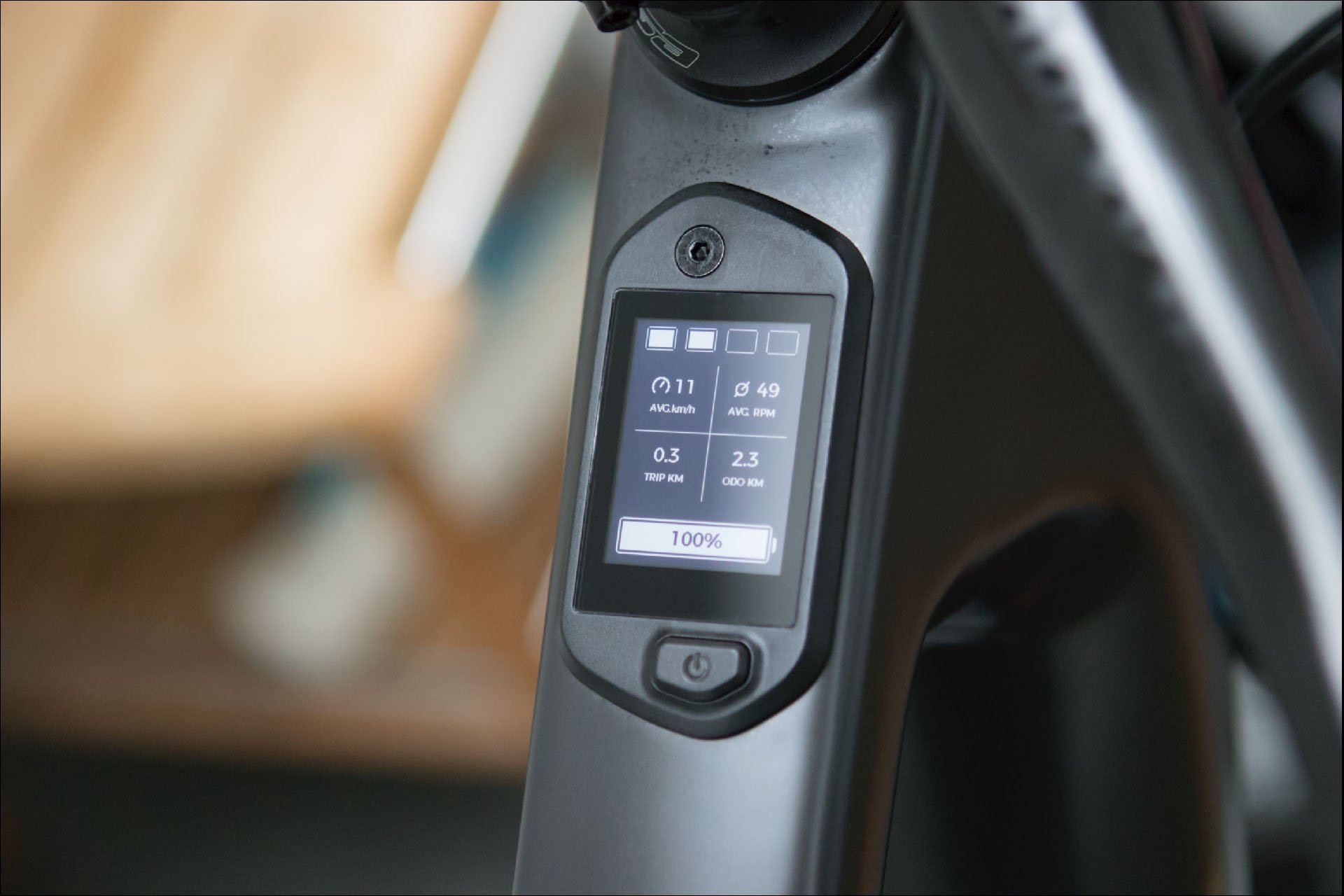
The Jumbotron is a step up, but the print is small and lacking colour making it difficult to read at a glance. The Important info, like speed, power level, and battery remaining, are clearly legible, but I prefer Shimano's colour coding for power level. I haven't yet confirmed if it has any illumination but it seems to have a little.
A Few Little Issues
When the bike arrived the shifting wasn't perfect. I couldn't adjust the cable tension to hit every gear on the way up. I assumed there was a problem with the cable but once it was detached it felt very smooth. Next I checked the hanger and it was slightly out of alignment, but not enough to impact Shimano's XT M8100 drivetrain. Eventually I realized the cable wasn't strung perfectly where it loops to meet the binder bolt. This would have been caught by a bike shop normally since Rocky Mountain is not a direct to consumer brand at this point but it took me some head scratching to sort it out.
I rode the Altitude in the BCBR Megavolt event last weekend and after a quick and sloppy hosing off the night before, the freehub was a little sticky, which caused the motor to stay engaged for the first couple of seconds when I started coasting downhill. This only lasted about 15 minutes and hasn't recurred.
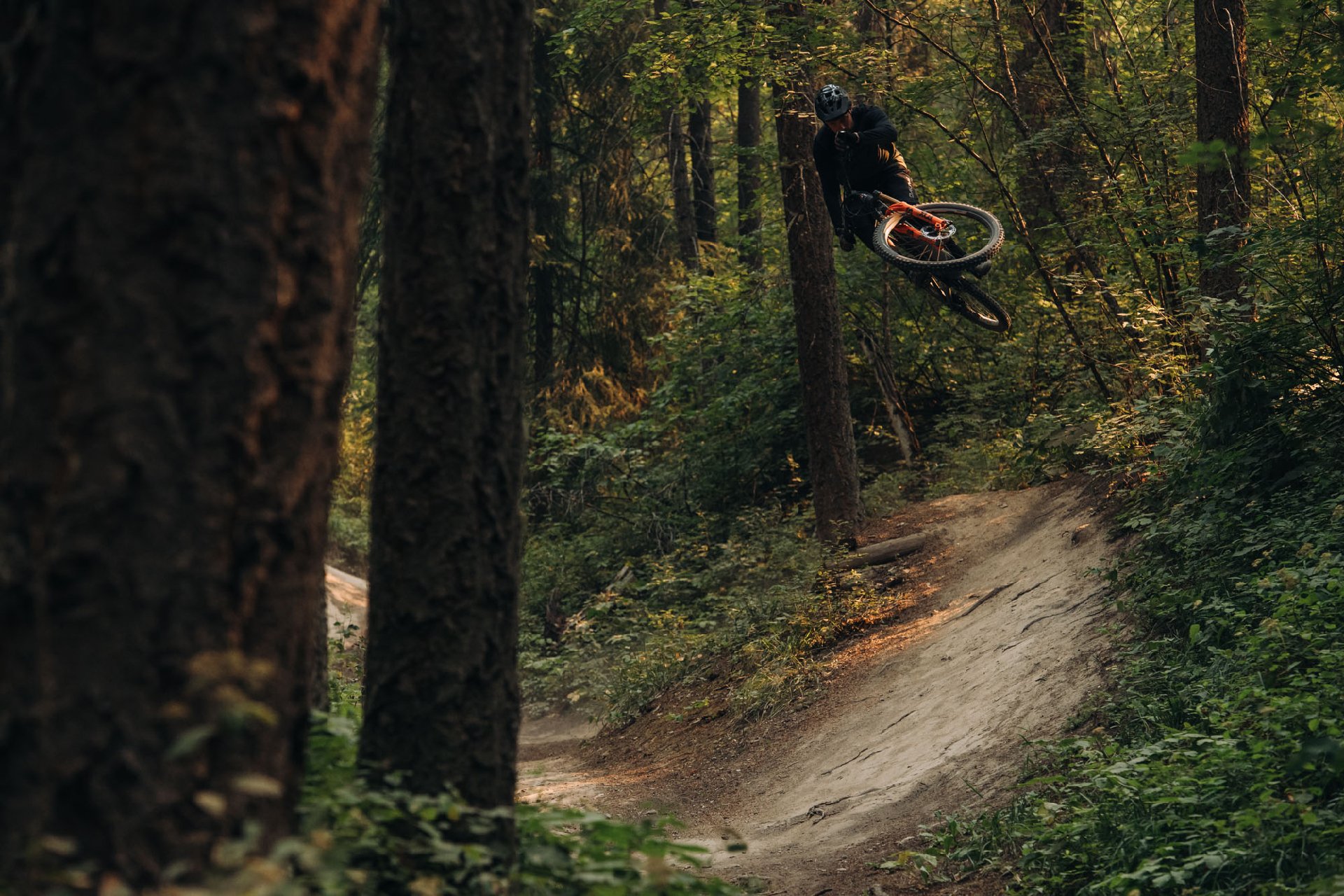
Thomas Vanderham sending the Altitude in Fernie B.C. Photos - Margus Riga
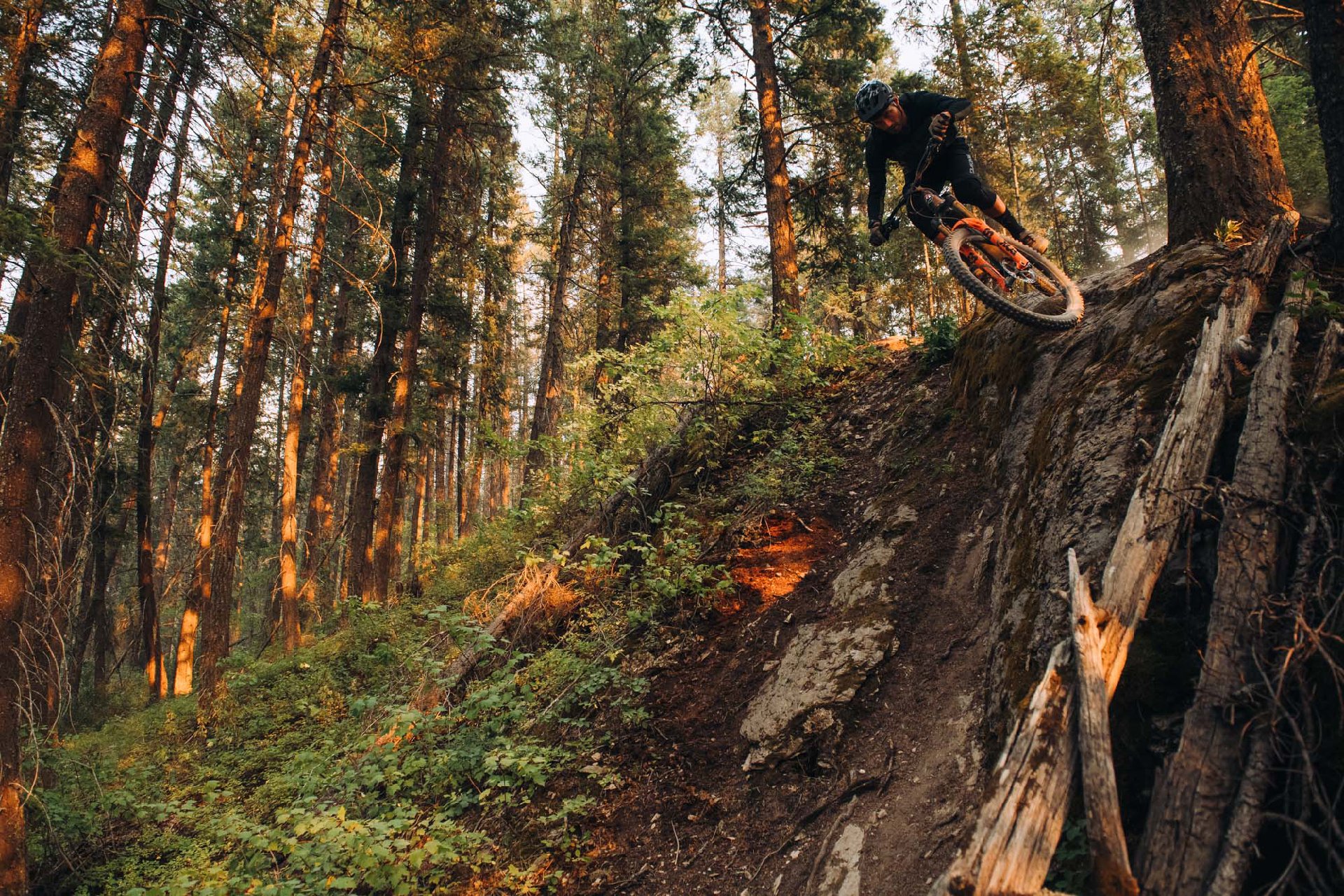
Another B.C. riding destination to explore.
As mentioned above, the Jumbotron's small characters are tricky for my old eyes because I don't wear glasses when I ride, and some colour would improve contrast and readability, but otherwise the execution and placement are excellent.
Before I read the spec. I assumed the stock post for the XL was only 170mm drop but it turns out I just got the wrong post and it should be a 200mm.
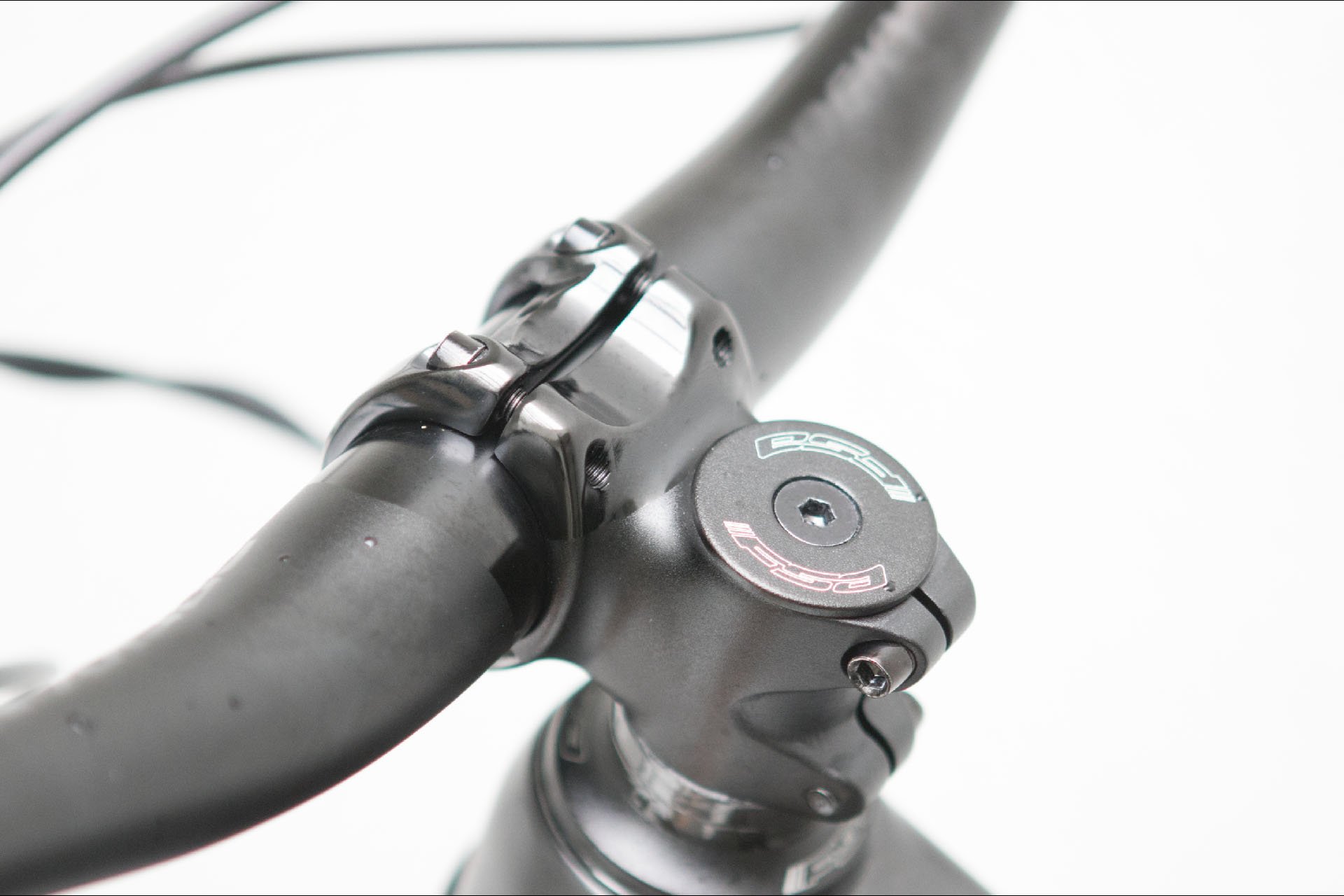
This stem looks fine, but I was hoping for more than fine.
Along with the Altitude, Rocky Mountain is releasing the Instinct today. It has 150/140mm of travel and is slightly less aggressive in every way. Pricing and availability information can be found below.
For more information on the Altitude and the Instinct PowerPlay, both with the new Dyname 4.0 motor, head over to Rocky Mountain Bicycles.

I'm looking forward to putting more time on this machine.
PRICING AND AVAILABILITY
The Altitude Powerplay and Instinct Powerplay will be available this winter from your local Rocky Mountain dealer. Regional availability may vary.
- Altitude Powerplay Carbon 90 Rally Edition: $13,129 CAD / $10,649 USD
- Altitude Powerplay Carbon 70: $11,339 CAD / $9,059 USD
- Altitude Powerplay Alloy 70: $9,239 CAD / $7,779 USD
- Altitude Powerplay Alloy 50: $8,399 CAD / $6,999 USD
- Altitude Powerplay Alloy 30 Coil: $7,349 CAD / $5,749 USD
- Instinct Powerplay Carbon 90: $14,699 CAD / $12,039 USD
- Instinct Powerplay Carbon 70: $11,549 CAD / $9,159 USD
- Instinct Powerplay Alloy 70: $8,819 CAD / $7,459 USD
- Instinct Powerplay Alloy 50: $7,769 CAD / $6,499 USD
- Instinct Powerplay Alloy 30: $6,929 CAD / $5,599 USD
Stay tuned for more once I log a bunch of rides on the newAltitude PP.
Height - 6'/183cm (mostly legs)
Weight - 170lbs/77kg
Inseam - 33"/84cm
Ape Index - 0.986
Age - 58
Trail I've been stoked on lately - Sam's Dad's Trail
Bar Width - 760mm
Preferred Reach - 485-500mm (longer with 27.5 wheels than 29)

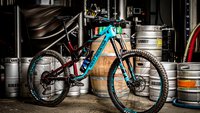
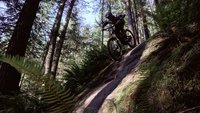








Comments
Zero-cool
2 years, 5 months ago
Ebikes are starting to look nice and more normal at last.
My only concern is the proprietary motor. I’ve been burned too many times in the past by proprietary equipment
Reply
Lu Kz
2 years, 5 months ago
I don't know if it counts for squat because electronics may be different and therefore not an apples to apples comparison, but Rocky Mountain keeps an impressive amount of older parts as stock items (not necessarily IN STOCK at the moment, courtesy COVID).... but I've phoned a few times reviving old COVID bikes and been shocked when they have stays, linkages, and hardware for some stuff that was getting real long in the tooth. Sure, they aren't publicizing a 10 year guarantee like Santa Cruz, but they do a better job than any of the other brands I've dealt with over my bike shop tenure. So if I trust anyone to support proprietary stuff for a long time, it's them.
Reply
Deniz Merdano
2 years, 5 months ago
Fine photos and even finer shower Cam!
The bike is aaaaalright too...
Reply
Vincent66
2 years, 5 months ago
Another toy I will never be able to afford ...
Reply
Dan
2 years, 5 months ago
Most of the price tags on these latest eMTBs make my eyes water, but honestly the Altitude Alloy 30 looks perfect to me as a +1 bike: alloy frame, totally acceptable mid grade suspension AND something I was recommending to a product manager of a different brand just the other day - full Deore *11*speed. The big a$$ battery and up to the minute geo (for the XL that I need) is just icing on the cake. Consider me very, very interested.
Reply
E-wok
2 years, 5 months ago
Thanks again, for another Emtb review. Keep them coming!
E=mtb2
Reply
Sean Chee
2 years, 5 months ago
It sounds like they have the PID tuning down nicely. My biggest complaint about both current shimano and specialized ebike systems has been the PID. No matter which mode I tried, they always felt awkward in their delivery.
PID loops that involve significant human inputs are really difficult to optimise. So in some ways it’s not surprising that the two S’s haven’t got it dialled in. On the other hand, given the resources the development would have taken, it is really disappointing that they haven’t got such a fundamental aspect of their operation right. My team has been optimising the behaviour of UAV’s and other robotics for years. If they gave me a bike for a month and sdk/tuning access, I could have it tuned to perfection.
Reply
Cooper Quinn
2 years, 5 months ago
Yeah. My partner has a Specialized, and my cargo bike has a Bosch system. The difference is night and day, I vastly prefer the Bosch.
Reply
Cam McRae
2 years, 5 months ago
Considering I had to look up what PID refers to, I have some catching up to do. It's one of those acronyms that isn't cleared up when you know what the letters refer to. Proportional, Integral, and Derivative; sounds a lot like calculus to me. After a couple of youtube videos, I'm getting the idea, but obviously part of the challenge here is that PID tuning in the system we are talking about is a matter of opinion. What feels great to one person and in one sort of terrain may feel wrong to another rider or in a different setting.
Does that make sense?
This was somewhat helpful to me. https://www.youtube.com/watch?v=wkfEZmsQqiA
Also - eMTBs are much more complicated than they seem from the saddle it turns out.
Reply
Sanesh Iyer
2 years, 5 months ago
There are some systems out there which "learn" PID control as well. I believe there's a ski suit that uses such a thing.
https://www.outsideonline.com/outdoor-adventure/snow-sports/roam-robotics-elevate-exoskeleton-skiing-future/
Would be cool to see eBikes do the same.
Reply
rockford
2 years, 5 months ago
Ah - 'adaptive' technology. It's cool, but if you lean on it too heavily as a hardware/software designer, then the system rides shitty until it learns enough to not ride shitty.
So you go get service, it loses the 'adaptive' part and you have a shitty system again until it re-learns. I've had cars like that. "Hey, we updated your transmission's firmware, so it'll shift rough for a little while while it re-learns". That transmission was part of a class-action lawsuit.
Good initial tuning and setup is best. Adaptive learning can be helpful in limited doses and ways.
Reply
Mammal
2 years, 5 months ago
Very much a calculus thing. My "Controls" classes, including PID material, was some of the most complicated and least interesting courses I took in my Mech Eng program, and I retained very little of it as a result. Super glad that there are those who excel at it though, as it's extremely important from so many control systems.
Reply
rockford
2 years, 5 months ago
PID isn't nearly as exotic as it might seem. It's quite intuitive if you are used to various feedback loops in your life. Your thermostat is the best and most simple example. It is on-off control, so not a PID, but that is a control loop in your house. I'll try to offer a simple explanation of PID, just for shits and giggles.
Basic version on an e-bike PID: it takes an input (torque sensor) and compares it to a setpoint (the amount of torque you are putting in times the assist setting you are in) and drives an output (motor torque) to have the input match the setpoint. The PID part effects how much of an output based on how far away you are from the input.
P = Proportional. If you are supposed to have 100 units of torque and you are only measuring 90, then you are 10 units away. Motor needs to add more jam. The P term multiplies that error (10 units) by the P gain setting to drive the motor that amount. So if P is 1, then the output would apply 10 units of torque. If it was 10, you'd get 100 units. This will create a response proportional to the error - hence the name. But it can be quite unstable if you have too much gain, and it'll oscillate - or shake like a dog shitting razor blades, as my old friend used to say. Not enough "P", and it has sluggish response and takes forever to reach the setpoint, if ever. The "I" comes in for the "if ever" scenario.
I = Integral. Yes, a calculus term, but the basics are that it is a gain term that applies output over time. So in the system above, if there is 10 units of error, and that error is present for 1 second, then the "I" term will apply more output to close that gap. If that added output closes the gap, but there is still error, the "I" term will add more output again. It stops adding output when there is no error. The issue with I is that it will keep adding, and create overshoot and have to unwind itself after, one cycle at a time. So it needs to be used judiciously.
D = Derivative. Another calculus term. And this one is generally the razors edge. It responds to a rate of change. So if the torque system is asking for 100 and getting 100 - happy system. P will be steady state, and I will be zero. If suddenly the torque value drops by 10, this is where D is listening and can respond. It'll see that quick drop and add output fast - before the P or I even see the error. The problem with D - if there is noise in the sensor, or in the motor output, then D sees nothing but quick errors and starts barking out orders a lot. Unless the feedback is deadly smooth, then D is typically not used. I've tuned 100's of PID's. 95%+ don't use D.
Reply
rockford
2 years, 5 months ago
This is all happening likely 1000 times per second (or faster in the equipment I use) so it's stuff that you monitor in a lab setting and watch plots of data and make adjustments. These are settings that are baked deeply into something like the motor system on an e-bike so they aren't something that anyone should (or can) monkey with.
The application variables are the things that should be tweaked - and very few people do so. I've solved some real issues by taking the bike and motor OEM to task and ensuring the stuff is setup right to start, and then I tweak the settings based on the riders feedback on behavior. Some people want to e-bike drag race their buddies uphill, and so we've had the pedal twitching, waiting for input. You touch it and it takes off. Other people want it so smooth that they don't want to know that there is "E". They just want the help. So we numb things and give them the ride qualities they want. So you are correct Cam - it's all very rider-specific.
E-bike tuning is a very deep well, and generally not well understood by most LBS's. It can make a big difference in the riders "E"xperience.
Reply
Jcmonty
2 years, 5 months ago
I would say that the Specialized SL (Levo SL and now KSL - I have had both) are definitely more natural feeling. The tune has been improved, and obviously, with less torque, there is a larger margin of error in terms of having too much or too little torque application via the motor. In "turbo" you can occasionally get overshoot I have found, but I am rarely in that mode.
I have found that tuning the starting "assist" to lower (i.e. 30 assist / 90 max power vs. 60 assist / 60 max power) also give a nice exponential feel that ramps with effort. Again - this is on specialized and YMMV when it comes to other tuning options.
It would be nice if they gave more advanced tuning options (ala PID tuning or whatever control scheme they are using). There is a lot that could be done to customize per rider feel. I could even imagine incorporating other sensors to sense grade, slip, etc for a pseudo traction control (whether or not that would be appreciated by MTBers). Working in the UAV space, if you want to know what PIDs can do, pick up that hobby! Control theory and application is very neat when it "clicks"
Reply
rockford
2 years, 5 months ago
Oh boy...the propellers are really starting to spin on the helmets now! PID's...NERD ALERT!!!
Sure, this thing will have a PID on the torque-loop, but the smoothness of onset and cut-off of power delivery is more down to jerk rates (yes, there's a thing in control systems called jerk rate), and also some other settings that can be adjusted that are generally more analogous to deadband, or dwell time. If the PID wasn't tuned right, you'd feel the crank surging as you pedaled (oscillations), or else lagging your stroke (overdamped). I haven't seen that characteristic in any proper e-bike I've worked on. Sketchy Costco ones, sure. But no reputable ones. I reckon the engineers at Shimano or Bosch have seen and tuned a PID or two ;) STEPS has been around since 2014, so they've had lots of time to get the bugs out. I've tuned many hundred PID's now, and don't think I could do much better than what is in the motors I've seen.
On the Shimano systems which I work on the most, they have some basic settings for users to adjust in the basic app/software. But if you get the more in-depth access (that shall not be named) then you can massage different parameters to address some of the issues that they come with out of the box.
Biggest issue out of the box: power carrying on after pedaling stops. Very prevalent in BOOST mode. You can tune that out pretty easy with the advanced features. But the Shimano system is the least tunable. Bosch is next. Specialized are more tunable. And I bet this system for RM (never worked on one) has some good access as it is only for them and a more 'boutiquey' powertrain system. I'd be keen to look under the hood of one sometime.
Shimano & Bosch systems have to work for so many different bikes and configurations that they have quite vanilla tuning and firmware. But OEMs like Norco, Kona, Trek, etc. have model specific firmware versions that do make it more customized to the bike. Incorporating things like motor angle and other variables that affect how the motor responds to clocking of the pedals for example are important to get the power delivery just right.
If you feel like your Shimano or Bosch isn't quite right, take it into the shop you got it from and ask them to verify it came loaded with the right firmware. I've seen quite a few e-bikes that have vanilla firmware and only a few picky customers that complained about some quirky behavior that I took the deep-dive on it and found that we needed to get OEM access and load the bike-specific parameters. Some it helped, others still felt it was quirky. But they were quirky customers too :)
Reply
Cam McRae
2 years, 5 months ago
Great info! Thanks for sharing that with us. There is so much to learn in this arena.
Reply
Sean Chee
2 years, 5 months ago
Apologies for disappearing after I dropped the three letter bomb. I’m currently at a remote location with limited connectivity. The current space weather has affected both our internet access and offered a pretty unique opportunity for our flight test campaign, so I’ve been flat out.
I will be the first to admit that I may be exceedingly picky in my assessment of the ebikes I’ve ridden, but both the ep8 and specialised systems felt distinctly unrefined and awkward. Not so much in the individual modes they were using but in the way that they are applied. Specifically it’s the i value that I believe needs tweaking. Both systems felt like they suffer from integral windup. Alternatively it could be a form of set point hunting.
Not knowing much about the members of the control loops, I couldn’t tell you where it’s coming from or which of the issues it’s likely to be. Maybe it’s the suggested stock firmware issue? Or maybe the model specific tuning didn’t do the systems justice? Regardless, control loops that contain significant human input, and are broad in their applications can be very difficult to tune.
The commander of this facility has a trek rail and I had a quick ride of it over the weekend. I will say that the Bosch system felt more consistent in its behaviour than the other two I have ridden this year. This doesn’t surprise me as I have previously worked with teams from Bosch and have been very impressed by their electric powertrain engineers. It’s probably the closest to a system that I would hand over money for. When I get back home next month, I will borrow a different friends Shimano equipped bike to see if I am being unreasonably critical or if my negative impressions are justified.
Btw this is a very short and easy to understand video that shows what each of the letter does.
https://youtu.be/qKy98Cbcltw
Reply
mrbrett
2 years, 5 months ago
Cam, what's that tile like to clean?
Reply
Cam McRae
2 years, 5 months ago
LOL. I was stumped for a second there. That tile is only above the tub so it's not a problem. In other words, it stays clean. In a shower it would likely be a PITA because of all that grout.
Reply
mrbrett
2 years, 5 months ago
Ha, bit of a comment puzzle. Thanks for the info - it's lovely to look at but I think in a shower surround it would look pretty miserable pretty quick (in my house at least). My bathroom needs a reno for about the cost of this bike before I am cleared to spend the cost of this bike so I have a little work to do.
Reply
Mark
2 years, 5 months ago
Modern grouts are actually pretty robust in terms of staying clean and being stain resistant as they have way more additives in them now.
Reply
Ride.DMC
2 years, 5 months ago
There is an error in the caption for the image of the Spec Sheet, which also lists the stem as being 40 metres :)
Reply
Cam McRae
2 years, 5 months ago
LOL. That's funny. Thanks!
Reply
Ddean
2 years, 5 months ago
Agree it’s a somewhat ambiguous line, but it seems it’s less so in DWV as the legal default for public land is, unless otherwise stated, all trails are all officially multiuse. There are of course situations where you’re not allowed to be on the land, and in that case it doesn’t matter if you’re walking or pedalling. However almost all public land trails prohibit motorized vehicles.
Reply
IslandLife
2 years, 5 months ago
So, I think I could see myself on an ebike full time in maybe 10 or 15 years or so (55 to 60)... maybe. I think things will probably make some huge strides by then (weight, cost, range battery life)... but I have questions around current battery durability, resale, parts etc..
If I spend 10k on this now... how much does the replacement battery cost when it craps out after 2 to 5 years of hard use or only has 50-60% of it's capacity left? Are replacement batteries available? And what's the cost? Is anyone willing to buy a 3 to 5 year old ebike that has been well used with a battery that has an unknown state? Would you have to replace it to get any kind of resale value? How's the long term durability of the motor? Does the software tell you the battery health? Is there anyway to objectively test the battery health? If I buy a used one and the battery dies in two months, what's my recourse? I see the battery warranty (for Rocky) is just two years... that kind of scares me... there's also a note that says "If stored for 3+ months, charge battery every 3 months. Failure to may cause damage." Off season for a lot of skiers/snowboarders is generally longer than 3 months... hope they're remembering to charge those batteries in January/February!
Anyone with some long term experience with e-bikes and their batteries? How long to they last? How much range is lost year to year? How many cycles are the batteries good for? Replacement costs? Willingness of buyers to buy in the used marketplace?
That's my main question right now... it's an awful lot of cash to outlay for something that may either be worthless in 5 years or require significant maintenance/upgrade expenses. I guess I'd just have to stay on the yearly or every second year flip cycle and make it someone else's problem... as long as they're willing to take on that liability? And does re-sale value drop because of that liability?
Reply
Nikita Morozov
2 years, 5 months ago
I had Shimano e8000 Merida e160 for a few years, now my friend owns it. I had two batteries, one came with the bike, other was purchased for around 300 USD (I have a friendly local Merida dealer, so the retail price might be closer to 430 USD). Both batteries were external and they are cheaper. After 4000 km and regularly switching the batteries, their health is 88 and 93 percent. I had one motor replaced that is still alive and used by other guy, while he was waiting almost a year for a new motor.
As for Turbo Levo I currently have, 700 Wh battery retail price is around 1100 USD, 500 Wh is around 850 USD. You might find it cheaper. After 1600 km I had my motor replaced, but it’s still alive. Also I have all harnesses for Levo due to terrible design of the motor enclosure and very bad waterproofing. Current battery health is 100% (but I assume it’s more like 97%).
Both motors were replaced according to Shimano and Specialized warranty policies: Shimano had some freeplay on crank shaft, Brose didn’t turn off power delivery after I stopped spinning pedals (it doesn’t spoil the ride, happens rarely, but if I spin eventually on a flat surface at 60 RPM and than accurately removing my feet from pedals, it can propel itself for a minute. New motor does the same, so I’ll claim the warranty after another 1600 km). But all of the above is not so awful, it actually barely tangible, so I just you it for a warranty claims, why not?
You should also count the wear and tear multiplication due to heavier system weight and greater torque. If you regularly clean and maintain your ebike, use 1.5 multiplication for wear and tear parts replacement. If you don’t, than use 2-4 multiplication. Also you should service your suspension more often. That’s how it is.
Reply
Michael
2 years, 5 months ago
You're kidding yourself if you don't think these things are the iPhones of this industry.
Unlike every other quality real bicycle (and many not so great quality ones) these are not going to be around 30 or 40+ years from now (you'd be lucky to get to 5) except in the form of toxic waste and land fill.
Reply
Cam McRae
2 years, 5 months ago
I think I can see your point, but 30 or 40 years? There isn't much that lasts that long currently. Or are you saying they'll be obsolete?
Reply
Michael
2 years, 5 months ago
The bike industry used to be a durable goods business. Many companies still aspire to this philosophy (thankfully). Yes modern full suspension mountain bikes changed that dynamic considerably with their increased complexity and much higher maintenance requirements to ensure a long life but even these if maintained well can last many years. Staying in the realm of mountain bikes something akin to a Starling and others like it could go even longer. But the subject of this article will have an owner needing a new battery only to be told... Sorry the company no longer provides firmware updates for that charge controller sir but hey we have this new model with the Quantum-fire chip its SO much better! I recently sold a Bianchi Randonnuer I refurbished, it was over 40 years old (one of several multi-decade old bicycles I have done this to), the young person who purchased it gets to move around the city on a bicycle several times their age, its still useful. Amsterdam and much of the Netherlands is filled with ancient bicycles still being useful (they get cold winters too.) Look I get it, I'm not a luddite but these things (and many other product industries) are exactly whats wrong with the way we think about manufacturing and consumption. The computerization and motorization of all things with wheels simply accelerates the extraction, consumption and ultimately the one way ticket to the landfill. In the case of e-things it also now includes highly toxic waste.
Reply
Cam McRae
2 years, 5 months ago
Excellent points. It makes one wonder how a big company could possibly find itself trying to make things last longer and support them deep into their life spans in this era when profit trumps every other consideration. There are certainly some exceptions in this industry, where the culture of the company and the individuals who make up the staff ensure an ethos that reflects the values you lament the loss of above, but they are becoming more scarce. It also must be difficult to transfer that ethos when a company is bought by a larger concern, which always makes numbers move up the priority ladder.
Long live old bikes!
Reply
Dan
2 years, 5 months ago
Well, two things I can think of - 1, i would not want the fully rigid Trek 830 Antelope that I bought 30 years ago last month. 2. recycling tech will undoubtedly continue to advance, and today’s bikes - e-powered or meat-powered - are equally likely to be recycled. That’s largely up to the consumer.
Reply
Ddean
2 years, 5 months ago
I'm not as opposed to these things as I have been in the past. I dont mind seeing them riding in most of the spots I ride, but hate seeing them in a few zones.
Many of the off-the-grid zones have no motorized vehicle signs up at the entrances and I know for a 100% fact that the DWV considers ebikes motorized vehicles that are not allowed to be in these places. The most upsetting thing is that I know of at least one local shop who sent (ie provided directions to a secret zone) new ebike buyers to one of these zones as a good place to take your shiny and charged up ebike as it will erase the climb that keeps most out.
You may see specific no ebiking signs going up as ebikers quote the various classes of vehicles when they say that the rules dont apply to them - buyer beware.
Im sure I will get one at one point.
Reply
Cam McRae
2 years, 5 months ago
This gets tricky when you are taking about areas where trails are unsanctioned already - meaning nobody should be riding on many of those zones if you follow the letter of the law. And the it becomes a live by the sword, die by the sword scenario.
I would never advocate sending inexperienced riders to sensitive zones personally, no matter what bike they are on. To me it makes more sense to allow riders to evolve and discover new terrain organically to moderate increases in traffic. Kind of the way the loam ranger suggests.
Reply
Please log in to leave a comment.